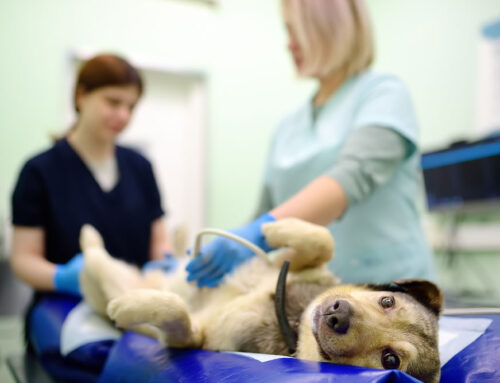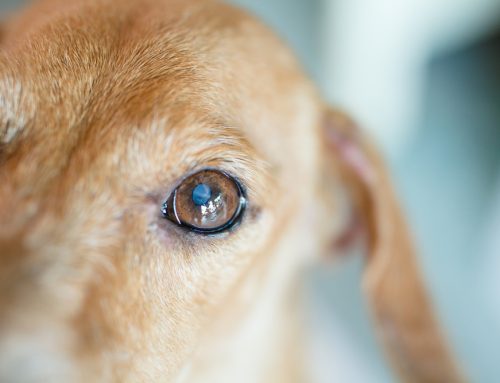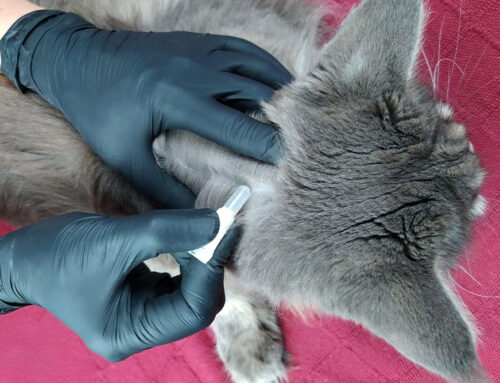
February is celebrated as National Dental Month in the veterinary world. Our purpose is a to shed light on a common disease found in cats and dogs and to educate pet parents on good oral care.
The following tips are helpful in identifying your pet’s need for dental care and how Southern Crossing Animal Hospital is here to helpwith routine dental care.
Although doggy and tuna breath seem perfectly normal, a pet’s stinky breath can be a sign of underlying dental disease. Most pets—up to 85%—have some stage of periodontal disease that affects their whole-body health by age 3, as poor oral hygiene can cause disease in other body parts. Follow our 10 dental-care tips to prevent painful periodontal disease from harming your pet.
#1: Know the dental-disease signs in your pet
Without knowing exactly what constitutes dental disease in pets, determining whether your furry friend is afflicted with poor dental health can be difficult. If your pet needs dental care, you may notice the following signs:
- Bad breath
- Red, swollen, inflamed gums
- Yellow or brown tartar accumulation on the teeth
- Gray, discolored teeth
- Broken teeth
- Thick, ropey saliva, possibly tinged with blood
- Reluctance to eat
- Pawing at the mouth
- Dropping food from one side of the mouth
- Bumps under the eyes on the muzzle
#2: Understand how poor dental health affects your pet’s well-being
Not only does periodontal disease affect your pet’s appetite, breath, and oral comfort, but it also can harm the kidneys, liver, and heart. An oral bacterial load that becomes too heavy can leach into the bloodstream and travel throughout your pet’s body, attacking the organs, and causing systemic infections.
#3: Learn how to brush your pet’s teeth
The gold standard of dental care, for pets and people, is twice daily toothbrushing. While adhering to such a schedule may be difficult, try to brush your pet’s teeth as often as possible. Start slowly to accustom your pet to a brush in their mouth, always using pet-safe toothpaste, and rewarding them with praise and treats on each step of the toothbrushing training path. Start by simply lifting the lip, proceed to touching the teeth with your finger, and then wipe your finger across the teeth. Introduce the toothbrush by slathering it with flavored pet-safe toothpaste and allowing your pet to lick off the paste before placing the brush briefly in their mouth. Once your pet is used to the toothbrush in their mouth, you can quickly scrub off the plaque each day before it can harden into cement-like tartar.

#4: Look for approved dental-health products for your pet
Not all dental-health products are created equal—many boast that they are the product veterinarians recommend to prevent dental disease, but few can back up that claim. Before purchasing a slew of dental-health products, check the Veterinary Oral Health Council (VOHC) list, which looks at the testing that companies perform and awards its seal of approval to products that slow plaque and tartar accumulation.
#5: Use a prescription dental diet if your pet suffers from poor dental health
Some pets are genetically predisposed to poor dental health and may need extra supportive care, making prescription dental diets a great accompaniment to an at-home dental-care regimen.
#6: Discuss dental health at your pet’s wellness visit
During your pet’s wellness visit, Drs. Nollner and White will check their teeth and gums for dental-disease signs and offer suggestions for preserving dental health. If you notice a suspicious foul odor in your pet’s mouth, don’t delay—schedule an exam sooner than her next wellness visit.
#7: Develop a dental-health routine
Once you’ve developed a daily dental-health routine for your pet, providing the necessary care is simple. Brush your pet’s teeth each night during your favorite TV show’s commercials, offer them a dental chew, or ask for tricks in exchange for dental treats.
#8: Avoid toys that are too tough to chew
Although some pets are “power chewers” and seem to have jaws of steel that can chew through anything, tough chews and toys can damage your pet’s teeth. We see painful tooth fractures in dogs who have gnawed on antlers and other tough chews, so opt for softer materials.
#9: Schedule regular dental cleanings

Since most pets have dental disease by age 3, your pet most likely will require a dental cleaning at some point to preserve good dental health. Stay ahead of the game and avoid periodontal problems with prophylactic dental cleanings designed to remove plaque and tartar before they can create painful gingivitis, bone loss, abscesses,tooth decay, or other systemic illness.
#10: Don’t miss National Pet Dental Health Month
We plan to celebrate National Pet Dental Health Month in February by offering a 10% discount on all dental cleanings that month. Appointments fill quickly, so give us a call to schedule your pet’s dental-care services.







Leave A Comment